Wafers

The Circular ones are what they look like before they are rolled and the long ones are the rolled wafers.
Wafer Irons
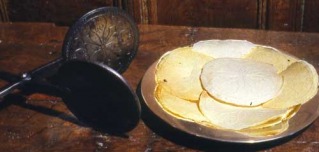
These are a plate of wafers with wafer irons which engranes the patterns and makes them flat.
Paper Wafers
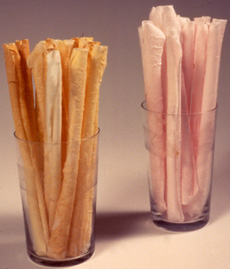
The unusual wafers (left) are unique in the history of English food. Flavoured with bergamot (left) and barberry (right) they were made from recipes written by the Georgian confectioner Frederick Nutt (1789). These delicious wafers were made by anointing wafer paper (similar to modern rice paper) with a mixture of egg white and citrus juice and then allowing the heat of a cool oven to curl them round a stick. A special utensil was used to achieve this. The finished result is the lightest and most delicious wafer ever eaten.
Title.
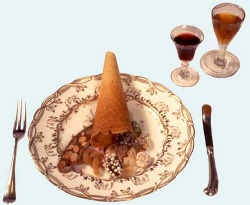
Although in modern times we associate wafer cornets with ice cream, they were probably originally served with the other sweetmeats during the dessert course. Since cannelons were filled with all sorts of fruit pastes and creams, it is probable that the very similar wafers were used in the same way. In the late eighteenth century English setting above, these 'funnels' or 'cornucopias' are served with diablotins (an early chocolate sweet covered in comfits), apricot knots and spice biscuits. Wafer cones are first mentioned in Bernard Claremont's The Professed Cook (London: 1769) and in Mary Smith's The Complete Housekeeper & Cook (Newcastle: 1770). Robin Weir has recently found some evidence to suggest that wafer cones were used for serving ice cream in France in the early nineteenth century. The earliest English record of this usage is in Charles Elmé Francatelli's The Modern Cook (London: 1846), in which he recommends cornets filled with ice cream as garnishes for a number of ice cream puddings, including the Iced Pudding à la Chesterfield. The popular theories that the ice cream cone was invented by Italo Marchiony in New York in 1896, or at the 1904 St. Louis World's Fair are entirely erroneous.
Title.
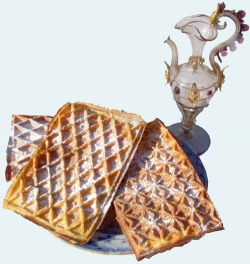
Flemish and Dutch wafers, leavened with yeast, what we would call waffles nowadays, were also popular in England in the early modern period. Those illustrated left were made from the following 1724 recipe.'Right', means true or authentic.
Take four Eggs, and beat them very well, then take a good Spoonful of a Pint of fine Sugar, one nutmeg grated, Cream, and a Pound of Flower, a Pound of butter melted, two or three Spoonfuls of Rose-water, and two good Spoonfuls of Yeast; mix all, well together, and bake them in your Wafer-tongs (as shown below) on the Fire. For the Sauce, take grated Cinnamon, Sack, and melted Butter, sweeten’d to your Taste.
Wafer Irons
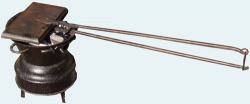
Baking Dutch Wafers over hot charcoal. Cooks and confectioners from Mary Kettilby's era would have used a charcoal stewing stove or chaffing dish to make wafers.
